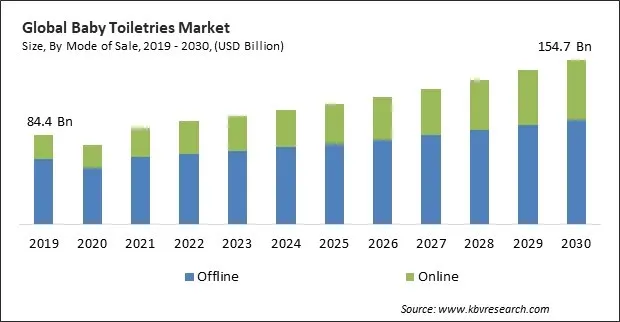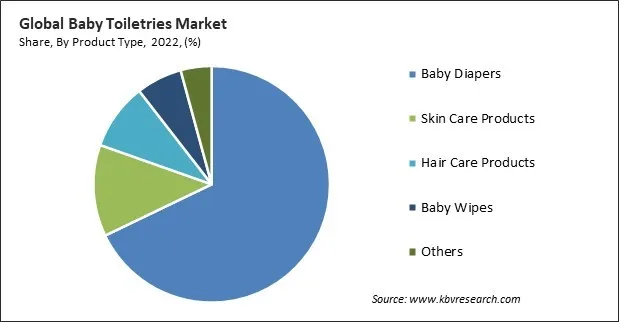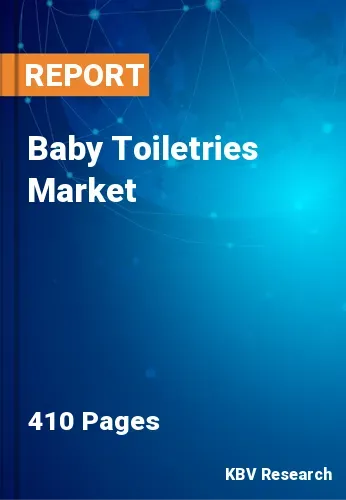The Global Baby Toiletries Market size is expected to reach $154.7 billion by 2030, rising at a market growth of 6.2% CAGR during the forecast period. In the year 2022, the market attained a volume of 21,342.0 million units, experiencing a growth of 6.0% (2019-2022).
Disposable diapers save valuable time compared to cloth diapers, which require washing and drying after each use. Thus, the disposable segment acquired $51,130.9 million in 2022. This time-saving aspect is especially beneficial for working parents or those with hectic schedules, allowing for easier integration into daily routines. Disposable diapers often incorporate advanced absorption technologies, such as superabsorbent polymers, which can hold a significant amount of liquid. This helps keep the baby's skin dry and minimizes the risk of diaper rash, providing enhanced comfort for the infant. Some of the factors impacting the market are advancements in formulations and technology, cultural shifts and changing lifestyles, and concerns about chemical ingredients in baby toiletries.

Continuous research in skincare science leads to discovering and utilizing innovative ingredients in baby toiletries. Advanced formulations incorporate botanical extracts, probiotics, vitamins, and minerals that cater to specific skin needs, providing enhanced nourishment and protection. Technological advancements allow for the creation of hypoallergenic and dermatologically tested baby toiletries. These formulations reduce the risk of skin allergies and irritations, assuring parents of the safety and compatibility of the products with their infants' delicate skin. Additionally, the rise of dual-income households has led to changing parenting dynamics. With both parents often working outside the home, there is an increased demand for convenient and time-saving baby toiletries. Products that offer efficiency and ease of use align with the busy schedules of modern parents. Older parents often prioritize quality and safety in baby products, leading to an increased demand for premium and specialized baby toiletries that cater to the specific needs of infants. The emphasis on wellness aligns with the demand for safer and more transparent product options. Thus, cultural shifts and changing lifestyles create a dynamic landscape for the market.
However, parents are becoming more discerning about the ingredients used in baby toiletries, leading to a growing demand for cleaner formulations. Chemicals such as parabens, sulfates, phthalates, and artificial fragrances are viewed with suspicion, prompting consumers to seek products with fewer or no harmful chemicals. Negative perceptions surrounding chemical ingredients can significantly impact a brand's reputation. Incidents of product recalls, safety concerns, or associations with harmful chemicals can lead to long-term damage to a brand's image and trustworthiness. Brands may need to invest in developing natural and hypoallergenic fragrance options, impacting the overall scent profile of their products. Therefore, the above factors will cause the market growth to decline.
Based on mode of sale, the market is fragmented into online and offline. In 2022, the offline sales segment registered the highest revenue share in the baby diapers market. Customers like to touch and feel the products before purchasing them to be satisfied with the quality of the money they are paying. Therefore, many retail outlets such as FirstCry and Babytown operate offline since the competition with the big giants such as Amazon and Flipkart have become a challenging task for the manufacturers. Supermarkets were initially introduced in developed countries and were a popular medium for the sale of products among manufacturers.
On the basis of product type, the market is segmented into baby diapers, skin care products, hair care products, baby wipes, and others. The baby wipes segment projected a prominent revenue share in the market in 2022. Baby wipes have evolved to feature gentle formulations specifically designed for infants' delicate and sensitive skin. Brands prioritize hypoallergenic ingredients free from harsh chemicals and suitable for daily use. These formulations aim to cleanse without causing irritation or dryness. Hydration and moisturization are key considerations in baby wipes. Formulations often include aloe vera, chamomile, and oat extracts to soothe and moisturize the skin.

Under baby diapers type, the market is further divided into disposable and reusable. The reusable segment acquired a substantial revenue share in the market in 2022. Reusable diapers are often made from natural fabrics like cotton, which is gentle on a baby's delicate skin. Cloth diapers allow better air circulation, lowering the risk of diaper rash and skin itching. Some babies with sensitive skin benefit from using breathable cloth materials. Reusable diapers often come with customizable absorbency options. Parents can choose different inserts or layering options to adjust absorbency based on their baby's needs, making them suitable for daytime and nighttime use. Many reusable diaper brands are produced locally or ethically, supporting local economies and ensuring fair labor practices. Parents who prioritize sustainable and ethical consumer choices may find this aspect appealing.
By end user, the market is classified into toddlers, infants, and newborn. In 2022, the toddlers segment generated the highest revenue share in the market. Toddler toiletries often include cleansing wipes that are convenient for on-the-go cleanups. These wipes are handy for quick cleanups after meals or outdoor activities. Many toddler toiletries come with mild and pleasant fragrances. These scents are designed to be appealing without overpowering, contributing to a positive and enjoyable bathing experience for toddlers. Toddler toiletries are formulated with the developmental stage of toddlers in mind. They address the transitional needs of toddlers with different skin and hair characteristics compared to infants or older children.
| Report Attribute | Details |
|---|---|
| Market size value in 2022 | USD 96.9 Billion |
| Market size forecast in 2030 | USD 154.7 Billion |
| Base Year | 2022 |
| Historical Period | 2019 to 2021 |
| Forecast Period | 2023 to 2030 |
| Revenue Growth Rate | CAGR of 6.2% from 2023 to 2030 |
| Number of Pages | 410 |
| Number of Table | 870 |
| Quantitative Data | Volume in Million Units, Revenue in USD Billion, and CAGR from 2019 to 2030 |
| Report coverage | Market Trends, Revenue Estimation and Forecast, Segmentation Analysis, Regional and Country Breakdown, Porter’s 5 Forces Analysis, Company Profiling, Companies Strategic Developments, SWOT Analysis, Winning Imperatives |
| Segments covered | Product Type, Mode of Sale, End User, Region |
| Country scope |
|
| Companies Included | Reckitt Benckiser Group PLC, California Baby, Artsana S.p.A., Johnson & Johnson, The Procter & Gamble Company, Kimberly-Clark Corporation, Svenska Cellulosa Aktiebolaget SCA, Beiersdorf AG, Weleda AG, Cotton Babies, Inc. |
| Growth Drivers |
|
| Restraints |
|
Region-wise, the market is analyzed across North America, Europe, Asia Pacific, and LAMEA. In 2022, the Asia Pacific region witnessed the largest revenue share in the market. The shift in consumer viewpoints toward hygiene and safety for babies. This region has been enhancing the living standards of consumers in advanced economies which is propelling the growth of the market in the region in the coming years. The rising disposable income, coupled with the high spending power and high baby care awareness are regarded to be a few factors that will propel the market growth during the forecast.
Free Valuable Insights: Global Baby Toiletries Market size to reach USD 154.7 Billion by 2030
The market research report covers the analysis of key stake holders of the market. Key companies profiled in the report include Reckitt Benckiser Group PLC, California Baby, Artsana S.p.A., Johnson & Johnson, The Procter & Gamble Company, Kimberly-Clark Corporation, Svenska Cellulosa Aktiebolaget SCA, Beiersdorf AG, Weleda AG, Cotton Babies, Inc.
By Mode of Sale (Volume, Million Units, USD Billion, 2019-2030)
By Product Type (Volume, Million Units, USD Billion, 2019-2030)
By End User (Volume, Million Units, USD Billion, 2019-2030)
By Geography (Volume, Million Units, USD Billion, 2019-2030)


This Market size is expected to reach $154.7 billion by 2030.
Advancements in formulations and technology are driving the Market in coming years, however, Concerns about chemical ingredients in baby toiletries restraints the growth of the Market.
Reckitt Benckiser Group PLC, California Baby, Artsana S.p.A., Johnson & Johnson, The Procter & Gamble Company, Kimberly-Clark Corporation, Svenska Cellulosa Aktiebolaget SCA, Beiersdorf AG, Weleda AG, Cotton Babies, Inc.
In the year 2022, the market attained a volume of 21,342.0 million units, experiencing a growth of 6.0% (2019-2022).
The Baby Diapers segment is leading the Market, By Product Type in 2022; thereby, achieving a market value of $99.7 billion by 2030.
The Asia Pacific region dominated the Market, By Region in 2022, and would continue to be a dominant market till 2030; thereby, achieving a market value of $64.2 billion by 2030.
Our team of dedicated experts can provide you with attractive expansion opportunities for your business.

